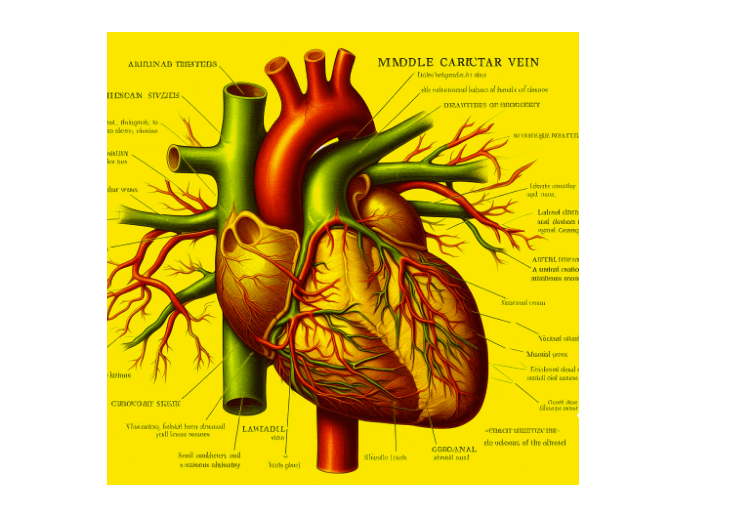Quick Overview
The middle cardiac vein (MCV), also known as the posterior interventricular vein, is one of the three main coronary veins that drains blood from the heart. It is responsible for draining the posterior wall of the left ventricle and the posterior interventricular septum.
The MCV originates at the apex of the heart and runs along the posterior interventricular groove. It empties into the coronary sinus, which then drains into the right atrium.
Table of Contents
Anatomy
The middle cardiac vein is a prominent vein that course its way through the myocardium, or the heart’s muscular wall. It typically arises from the posterior aspect of the left ventricle and runs along the heart’s surface.
| Vein | Description |
| Origin | Apex of the heart |
| Branches | Diagonal branches, Septal branches, Marginal branches |
| Location | Heart’s posterior surface |
| Drainage | Venous drainage of the heart |
Location
This MCV is located on the heart’s posterior surface, nestled amidst the cardiac muscle. It meanders in the atrioventricular (AV) sulcus, a groove on the heart’s surface that separates the atria from the ventricles.
Function
The middle cardiac vein plays a crucial role in draining deoxygenated blood from the heart’s muscular walls. It collects metabolic waste and carbon dioxide-rich blood from the myocardium, ensuring that the heart remains healthy and functional.
Branches
The MCV has a number of branches, including:
- Diagonal branches: These branches drain blood from the posterior wall of the left ventricle.
- Septal branches: These branches drain blood from the posterior interventricular septum.
- Marginal branches: These branches drain blood from the inferior border of the heart.
Venous Drainage
The middle cardiac vein plays a central role in the venous drainage of the heart, serving as a conduit for blood returning from the heart’s muscle tissue. It transports this deoxygenated blood back to the right atrium, where it can be sent to the lungs for oxygenation.
Clinical Importance
The MCV holds a significant clinical importance. It is a common site for the placement of pacemaker leads and other cardiac devices.
Cardiologists and surgeons often utilize the middle cardiac vein for access to the heart’s electrical conduction system or for delivering therapies.
Conditions Associated with the MCV
A number of conditions can affect the MCV, including:
- Myocardial infarction (heart attack): A myocardial infarction is a blockage in one of the coronary arteries that supply blood to the heart. This can lead to damage or death of heart muscle.
- Coronary artery disease (CAD): CAD is a condition in which the coronary arteries become narrowed or blocked. This can reduce blood flow to the heart and lead to a myocardial infarction.
- Cardiomyopathy: Cardiomyopathy is a condition that affects the heart muscle. This can lead to weakening of the heart muscle and reduced blood flow to the heart.
- Congenital heart disease: Congenital heart disease is a condition that is present at birth. Some types of congenital heart disease can affect the coronary arteries or the heart muscle.
Prevention of MCV Disorders
There are a number of things you can do to prevent middle cardiac vein disorders, including:
- Maintaining a healthy weight
- Eating a healthy diet
- Exercising regularly
- Quitting smoking
- Managing high blood pressure and cholesterol levels
- Controlling diabetes
Question
1. Middle Cardiac Vein runs with what artery?
The Middle Cardiac Vein typically runs alongside the Anterior Interventricular Artery, also known as the Left Anterior Descending (LAD) Artery.
2. The Great Cardiac Vein and the Middle Cardiac Vein lead to what vessel?
Both the Great Cardiac Vein and the Middle Cardiac Vein ultimately lead to the Coronary Sinus, which is a larger vein located on the posterior surface of the heart.
3. Where is the position of the Middle Cardiac Vein?
The Middle Cardiac Vein is situated on the posterior surface of the heart, coursing through the atrioventricular (AV) sulcus, which is a groove that separates the atria from the ventricles.
4. What does the Middle Cardiac Vein drain?
The Middle Cardiac Vein primarily drains deoxygenated blood and metabolic waste from the heart’s muscular walls, ensuring the removal of waste products from the myocardium.
5. Middle Cardiac Vein function:
The primary function of the Middle Cardiac Vein is to facilitate the venous drainage of the heart’s muscle tissue, ensuring that deoxygenated blood is collected and transported back to the right atrium for eventual circulation to the lungs for oxygenation.

